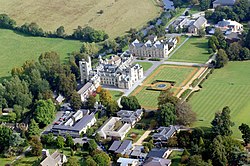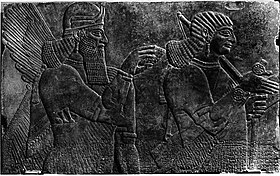Canford School
| Canford School | |
|
Dorset | |
|---|---|

| |
| Type: | School |
| Location | |
| Grid reference: | SZ03379891 |
| Location: | 50°47’23"N, 1°57’13"W |
| Village: | Canford |
| History | |
| School | |
| Information | |
Canford School is a coeducational independent school for day and boarding pupils. Situated in 300 acres of parkland near to the market town of Wimborne Minster in Dorset, south west England, it is one of the largest schools by area.
The school is a member of the Headmasters' and Headmistresses' Conference.[1] Called a public school, Canford's fees are currently £12,686 per term for boarders.[2] The school is rated outstanding by Ofsted and is consistently ranked among the best co-educational independent schools nationally. In 2014, and again in 2016, Canford was among four runners-up for "Public School of the Year" in the Tatler School Awards and received the top award in 2019.[3][4]
Canford School counts among its alumni high-ranking military officers, pioneers in industry, computing, and economics, as well as senior figures in the Arts and Sciences.
History
Canford Manor was particularly associated with John of Gaunt, 1st Duke of Lancaster - the third of five surviving sons of King Edward III and founder of the House of Lancaster, He was the most powerful man in England while his nephew King Richard II was yet of the age of minority and amassed great wealth in terms of land grants to become one of the richest, and most powerful, men of his era. Records suggest the Canford Manor was used as a principal residence of John of Gaunt for some time. Of that early period, only the Norman church and 14th century refectory known as John O' Gaunt's Kitchen remains.
The main building, constituting the nucleus of the school, was designed by Edward Blore and later by Sir Charles Barry in the early and mid 1800s. The school itself was founded in 1923, having been "provided with a nucleus of boys and staff from a small private school in Weston-super-Mare".[5]
Assyrian frieze

In 1992, a lost Assyrian stone relief was rediscovered on the wall of "the Grubber".[6]
Although it is at first sight rather unlikely that such a valuable item should be found on the wall of a school tuck shop, the history of the school explains how the relief came to be there. It had been brought back from the site of Nimrud in northern Mesopotamia by Sir Austen Henry Layard along with other antiquities which were displayed at Canford before it was a school. Originally Canford had been a private country house, known as Canford Manor, designed by Edward Blore and improved by Sir Charles Barry, and the residence of Layard's cousin and mother-in-law, Lady Charlotte Guest and her husband, Sir John Josiah Guest. At that time, the building now known as the Grubber had been used to display antiquities and was known as "the Nineveh Porch". It was however believed by the school authorities to be a plaster copy of an original which had been lost overboard during river transit and little attention was paid to it after the school was established. A dartboard was even hung in the Grubber close to where the frieze was displayed. It was John Russell of Columbia University who identified the frieze as an original, one of a set of three relief slabs taken from the throne room of Assyrian King Assurnasirpal II (883–859 BC).
A new plaster copy now stands in the foyer of the Layard Theatre at Canford and a number of "Assyrian Scholarships" are available, funded from the sale proceeds which also helped pay for the construction of a new sports facility.[7]
The original relief is now part of the collection of the Miho Museum in Japan.[8][9]
The Layard Theatre
The Layard Theatre is situated inside Canford School and is open to the public.[10]
Outside links
| ("Wikimedia Commons" has material about Canford School) |
References
- ↑ "HMC Schools Directory". HMC. http://www.hmc.org.uk/schools. Retrieved 19 February 2018.
- ↑ "Fees". Canford School. https://www.canford.com/Fees. Retrieved 19 February 2018.
- ↑ "Tatler Schools Awards 2014 – the winners". Tatler. 2014. http://www.tatler.com/article/tatler-schools-awards-2014-the-winners. Retrieved 19 February 2018.
- ↑ "Tatler Schools Guide 2020". Tatler. 2016. https://www.tatler.com/article/top-public-schools-in-the-south-west-wales. Retrieved 19 February 2018.
- ↑ "Dorset Natural History and Archaeological Society, Volumes 94-99, 1973, Dorset Natural History and Archaeological Society, Archaeology". p. 153. https://books.google.co.uk/books?id=8-0qAAAAMAAJ&q=%22canford+school+was+founded%22&dq=%22canford+school+was+founded%22&hl=en&sa=X&ved=0ahUKEwjq9o2Py6HcAhVsAsAKHZArB6UQ6AEILzAB. Retrieved 11 March 2018.
- ↑ Russell, John Malcolm, ed (1997). From Nineveh to New York: The strange story of the Assyrian reliefs in the Metropolitan Museum and the hidden masterpiece at Canford School. New Haven/London: Yale University Press; New York: The Metropolitan Museum of Art. https://archive.org/details/fromninevehtonew00john.
- ↑ "Assyrian Frieze | Canford School". Canford.com. https://www.canford.com/Assyrian-Frieze. Retrieved 2018-02-18.
- ↑ McKenzie, Judith (1997). "10". Canford School. pp. 173–189.
- ↑ Paley, Samuel M. (1999). "A winged genius and royal attendant from the Northwest Palace at Nimrud". Bulletin of the Miho Museum 2: 17–29, Plate 1.
- ↑ "Layard Theatre". Ticket Source. https://www.ticketsource.co.uk/the-layard-theatre. Retrieved 15 July 2018.
- Sumption, Jonathan (2009). The Hundred Years War: Divided houses. Volume III. Faber and Faber. ISBN 978-0571138975.
